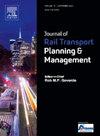Demand-based capacity assessment using mixed integer programming
IF 2.7
Q3 TRANSPORTATION
Journal of Rail Transport Planning & Management
Pub Date : 2025-01-15
DOI:10.1016/j.jrtpm.2024.100502
引用次数: 0
Abstract
Understanding railway network capacity and potential reserves proves crucial for optimal planning decisions, which are required due to the high utilization of European railway networks and the intended future modal shift to rail. Capacity reserves emerge where the network structure does not match the demand. We propose a mixed integer program (MIP) for investigating the demand-based capacity reserves in the network. Extending the MIP-based railway network utilization model by adding demand structures, our model allows to optimize the train ordering and the locations of trains in the network, whilst regarding for the traffic demand to be served. The infrastructure is mesoscopically modelled by the individual blocks of the railway system. The demand is represented by a corresponding line plan and its given frequencies. The model determines the interrelations of demand and network capacity and thus allows to investigate between transport demand and network infrastructure. We test the proposed model on different artificial networks and a case study. In particular, the results show clear capacity effects of mismatched infrastructural demand and supply. It is thereby shown, that the efficient use of network capacity depends on the fit between demand and network structure. Furthermore, we can see that the emergent utilization behaviour is network specific and often non-linear, which strengthens the necessity of network approaches for global capacity assessment. Also providing support to other fields such as urban planning, the models incorporation to integrated and interdisciplinary planning approaches is left for future research.
使用混合整数规划的基于需求的容量评估
了解铁路网络容量和潜在储量对于优化规划决策至关重要,这是由于欧洲铁路网络的高利用率和预期的未来模式向铁路转变所必需的。当网络结构与需求不匹配时,就会出现容量储备。我们提出了一种混合整数规划(MIP)来研究基于需求的电网容量储备。通过增加需求结构,扩展基于mip的铁路网利用模型,我们的模型可以在考虑所要服务的交通需求的同时,优化列车排序和网络中列车的位置。基础设施是由铁路系统的各个模块在细观上建模的。需求由相应的线路平面图及其给定的频率表示。该模型确定了需求和网络容量之间的相互关系,从而可以调查运输需求和网络基础设施之间的关系。我们在不同的人工网络和案例研究中测试了所提出的模型。特别是,研究结果显示了基础设施供需不匹配的产能效应。由此可见,网络容量的有效利用取决于需求与网络结构的契合度。此外,我们可以看到,紧急利用行为是网络特有的,往往是非线性的,这加强了网络方法进行全球容量评估的必要性。同时也为城市规划等其他领域提供了支持,这些模型与综合和跨学科规划方法的结合有待于未来的研究。
本文章由计算机程序翻译,如有差异,请以英文原文为准。
求助全文
约1分钟内获得全文
求助全文
来源期刊

Journal of Rail Transport Planning & Management
TRANSPORTATION-
CiteScore
7.10
自引率
8.10%
发文量
41
 求助内容:
求助内容: 应助结果提醒方式:
应助结果提醒方式:


